Analysis of ICT Project Management: Methodologies and Implementation
VerifiedAdded on 2023/06/09
|8
|1211
|176
Report
AI Summary
This report provides a comprehensive overview of ICT project management methodologies, highlighting their significance in strategic alignment, leadership, and realistic project planning. It contrasts the Waterfall and Agile methodologies, detailing their differences and similarities, and discusses critical path methodology (CPM) and hybrid methods. The report emphasizes the importance of selecting the right project methodology, considering frameworks like PMBOK and SDLC to ensure quality, timely delivery, and adherence to budget and client specifications, ultimately contributing to project success and the execution of business strategies. Desklib offers a wealth of resources, including solved assignments and past papers, to further assist students in mastering project management concepts.
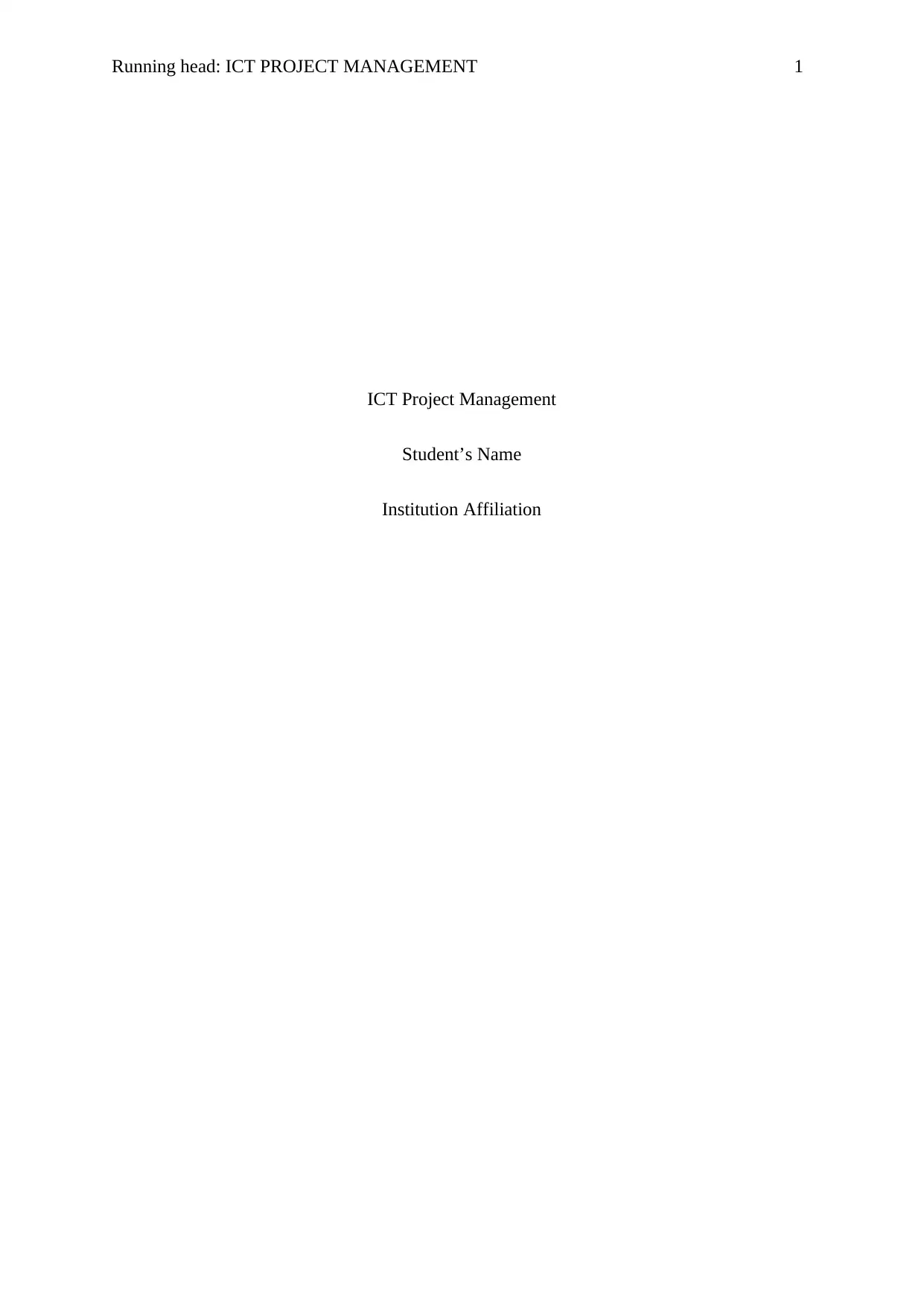
Running head: ICT PROJECT MANAGEMENT 1
ICT Project Management
Student’s Name
Institution Affiliation
ICT Project Management
Student’s Name
Institution Affiliation
Paraphrase This Document
Need a fresh take? Get an instant paraphrase of this document with our AI Paraphraser
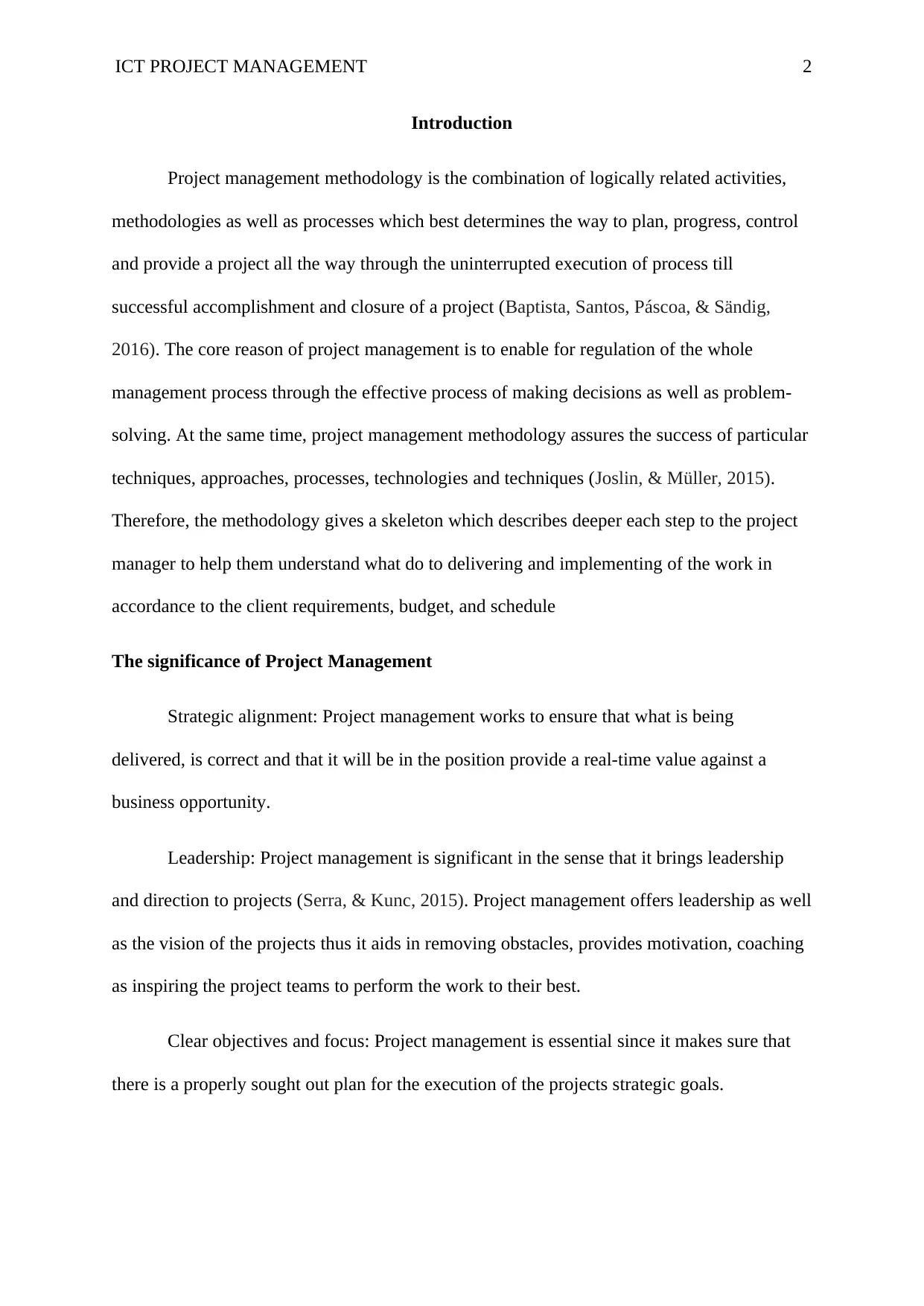
ICT PROJECT MANAGEMENT 2
Introduction
Project management methodology is the combination of logically related activities,
methodologies as well as processes which best determines the way to plan, progress, control
and provide a project all the way through the uninterrupted execution of process till
successful accomplishment and closure of a project (Baptista, Santos, Páscoa, & Sändig,
2016). The core reason of project management is to enable for regulation of the whole
management process through the effective process of making decisions as well as problem-
solving. At the same time, project management methodology assures the success of particular
techniques, approaches, processes, technologies and techniques (Joslin, & Müller, 2015).
Therefore, the methodology gives a skeleton which describes deeper each step to the project
manager to help them understand what do to delivering and implementing of the work in
accordance to the client requirements, budget, and schedule
The significance of Project Management
Strategic alignment: Project management works to ensure that what is being
delivered, is correct and that it will be in the position provide a real-time value against a
business opportunity.
Leadership: Project management is significant in the sense that it brings leadership
and direction to projects (Serra, & Kunc, 2015). Project management offers leadership as well
as the vision of the projects thus it aids in removing obstacles, provides motivation, coaching
as inspiring the project teams to perform the work to their best.
Clear objectives and focus: Project management is essential since it makes sure that
there is a properly sought out plan for the execution of the projects strategic goals.
Introduction
Project management methodology is the combination of logically related activities,
methodologies as well as processes which best determines the way to plan, progress, control
and provide a project all the way through the uninterrupted execution of process till
successful accomplishment and closure of a project (Baptista, Santos, Páscoa, & Sändig,
2016). The core reason of project management is to enable for regulation of the whole
management process through the effective process of making decisions as well as problem-
solving. At the same time, project management methodology assures the success of particular
techniques, approaches, processes, technologies and techniques (Joslin, & Müller, 2015).
Therefore, the methodology gives a skeleton which describes deeper each step to the project
manager to help them understand what do to delivering and implementing of the work in
accordance to the client requirements, budget, and schedule
The significance of Project Management
Strategic alignment: Project management works to ensure that what is being
delivered, is correct and that it will be in the position provide a real-time value against a
business opportunity.
Leadership: Project management is significant in the sense that it brings leadership
and direction to projects (Serra, & Kunc, 2015). Project management offers leadership as well
as the vision of the projects thus it aids in removing obstacles, provides motivation, coaching
as inspiring the project teams to perform the work to their best.
Clear objectives and focus: Project management is essential since it makes sure that
there is a properly sought out plan for the execution of the projects strategic goals.
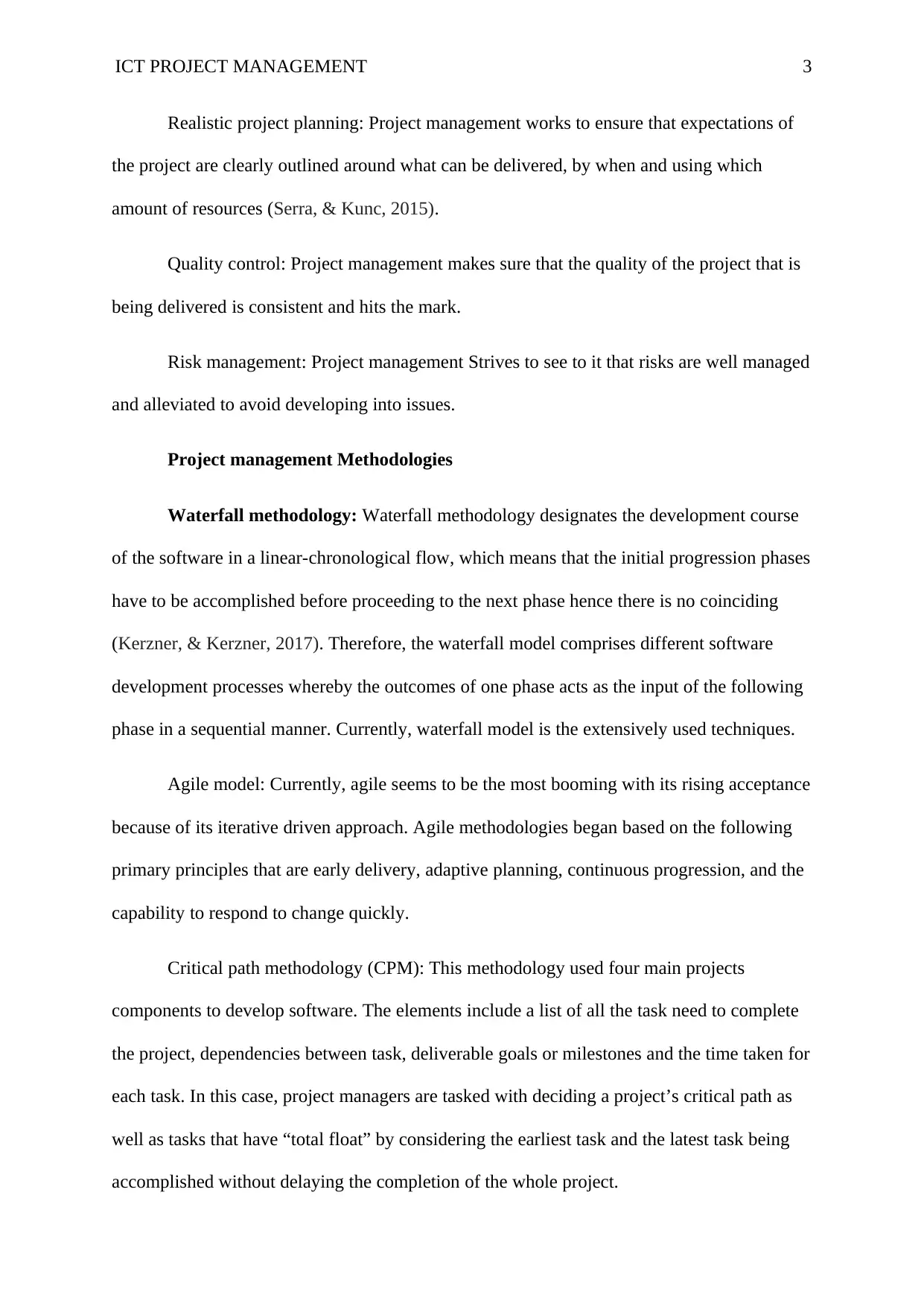
ICT PROJECT MANAGEMENT 3
Realistic project planning: Project management works to ensure that expectations of
the project are clearly outlined around what can be delivered, by when and using which
amount of resources (Serra, & Kunc, 2015).
Quality control: Project management makes sure that the quality of the project that is
being delivered is consistent and hits the mark.
Risk management: Project management Strives to see to it that risks are well managed
and alleviated to avoid developing into issues.
Project management Methodologies
Waterfall methodology: Waterfall methodology designates the development course
of the software in a linear-chronological flow, which means that the initial progression phases
have to be accomplished before proceeding to the next phase hence there is no coinciding
(Kerzner, & Kerzner, 2017). Therefore, the waterfall model comprises different software
development processes whereby the outcomes of one phase acts as the input of the following
phase in a sequential manner. Currently, waterfall model is the extensively used techniques.
Agile model: Currently, agile seems to be the most booming with its rising acceptance
because of its iterative driven approach. Agile methodologies began based on the following
primary principles that are early delivery, adaptive planning, continuous progression, and the
capability to respond to change quickly.
Critical path methodology (CPM): This methodology used four main projects
components to develop software. The elements include a list of all the task need to complete
the project, dependencies between task, deliverable goals or milestones and the time taken for
each task. In this case, project managers are tasked with deciding a project’s critical path as
well as tasks that have “total float” by considering the earliest task and the latest task being
accomplished without delaying the completion of the whole project.
Realistic project planning: Project management works to ensure that expectations of
the project are clearly outlined around what can be delivered, by when and using which
amount of resources (Serra, & Kunc, 2015).
Quality control: Project management makes sure that the quality of the project that is
being delivered is consistent and hits the mark.
Risk management: Project management Strives to see to it that risks are well managed
and alleviated to avoid developing into issues.
Project management Methodologies
Waterfall methodology: Waterfall methodology designates the development course
of the software in a linear-chronological flow, which means that the initial progression phases
have to be accomplished before proceeding to the next phase hence there is no coinciding
(Kerzner, & Kerzner, 2017). Therefore, the waterfall model comprises different software
development processes whereby the outcomes of one phase acts as the input of the following
phase in a sequential manner. Currently, waterfall model is the extensively used techniques.
Agile model: Currently, agile seems to be the most booming with its rising acceptance
because of its iterative driven approach. Agile methodologies began based on the following
primary principles that are early delivery, adaptive planning, continuous progression, and the
capability to respond to change quickly.
Critical path methodology (CPM): This methodology used four main projects
components to develop software. The elements include a list of all the task need to complete
the project, dependencies between task, deliverable goals or milestones and the time taken for
each task. In this case, project managers are tasked with deciding a project’s critical path as
well as tasks that have “total float” by considering the earliest task and the latest task being
accomplished without delaying the completion of the whole project.
⊘ This is a preview!⊘
Do you want full access?
Subscribe today to unlock all pages.

Trusted by 1+ million students worldwide
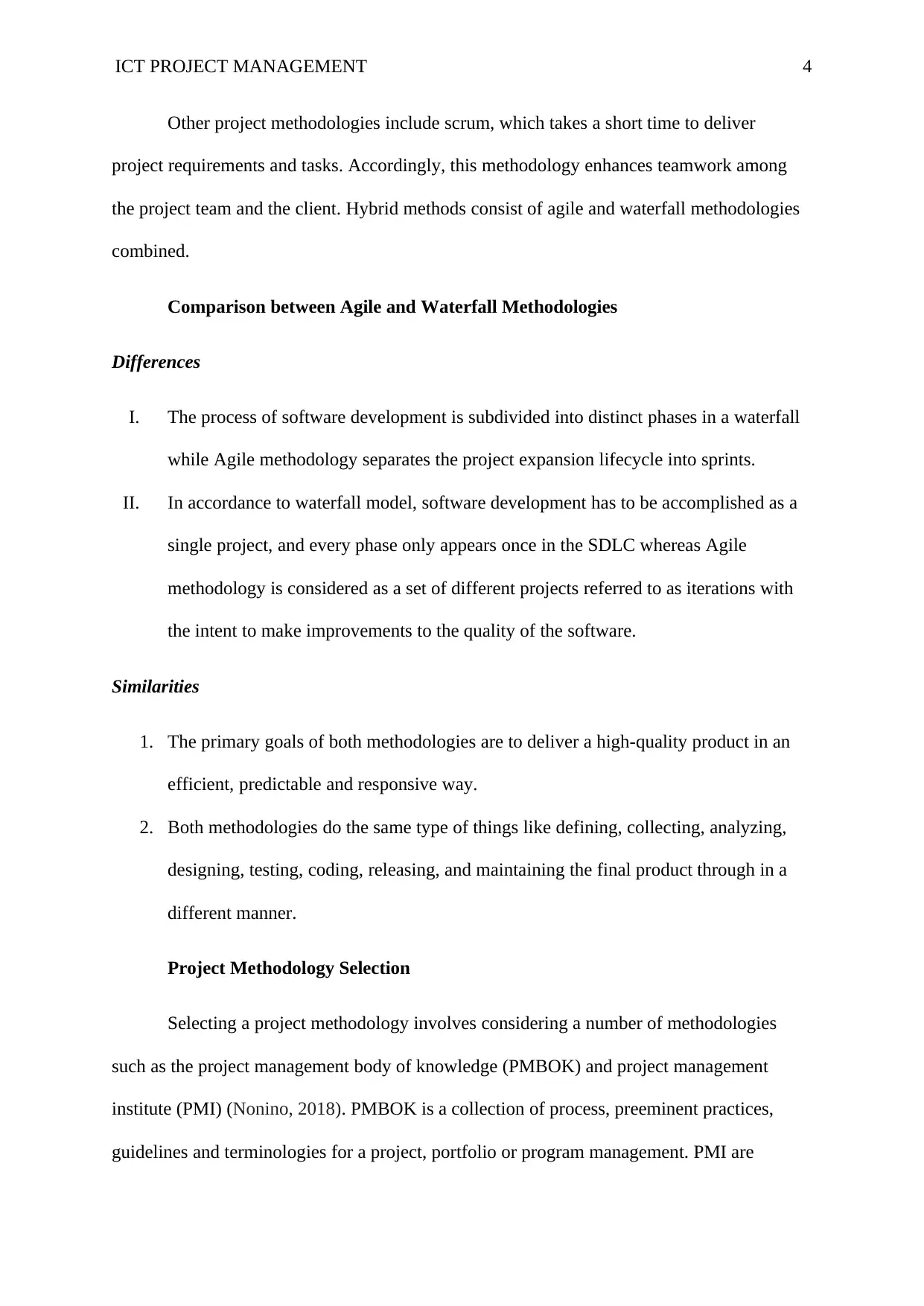
ICT PROJECT MANAGEMENT 4
Other project methodologies include scrum, which takes a short time to deliver
project requirements and tasks. Accordingly, this methodology enhances teamwork among
the project team and the client. Hybrid methods consist of agile and waterfall methodologies
combined.
Comparison between Agile and Waterfall Methodologies
Differences
I. The process of software development is subdivided into distinct phases in a waterfall
while Agile methodology separates the project expansion lifecycle into sprints.
II. In accordance to waterfall model, software development has to be accomplished as a
single project, and every phase only appears once in the SDLC whereas Agile
methodology is considered as a set of different projects referred to as iterations with
the intent to make improvements to the quality of the software.
Similarities
1. The primary goals of both methodologies are to deliver a high-quality product in an
efficient, predictable and responsive way.
2. Both methodologies do the same type of things like defining, collecting, analyzing,
designing, testing, coding, releasing, and maintaining the final product through in a
different manner.
Project Methodology Selection
Selecting a project methodology involves considering a number of methodologies
such as the project management body of knowledge (PMBOK) and project management
institute (PMI) (Nonino, 2018). PMBOK is a collection of process, preeminent practices,
guidelines and terminologies for a project, portfolio or program management. PMI are
Other project methodologies include scrum, which takes a short time to deliver
project requirements and tasks. Accordingly, this methodology enhances teamwork among
the project team and the client. Hybrid methods consist of agile and waterfall methodologies
combined.
Comparison between Agile and Waterfall Methodologies
Differences
I. The process of software development is subdivided into distinct phases in a waterfall
while Agile methodology separates the project expansion lifecycle into sprints.
II. In accordance to waterfall model, software development has to be accomplished as a
single project, and every phase only appears once in the SDLC whereas Agile
methodology is considered as a set of different projects referred to as iterations with
the intent to make improvements to the quality of the software.
Similarities
1. The primary goals of both methodologies are to deliver a high-quality product in an
efficient, predictable and responsive way.
2. Both methodologies do the same type of things like defining, collecting, analyzing,
designing, testing, coding, releasing, and maintaining the final product through in a
different manner.
Project Methodology Selection
Selecting a project methodology involves considering a number of methodologies
such as the project management body of knowledge (PMBOK) and project management
institute (PMI) (Nonino, 2018). PMBOK is a collection of process, preeminent practices,
guidelines and terminologies for a project, portfolio or program management. PMI are
Paraphrase This Document
Need a fresh take? Get an instant paraphrase of this document with our AI Paraphraser
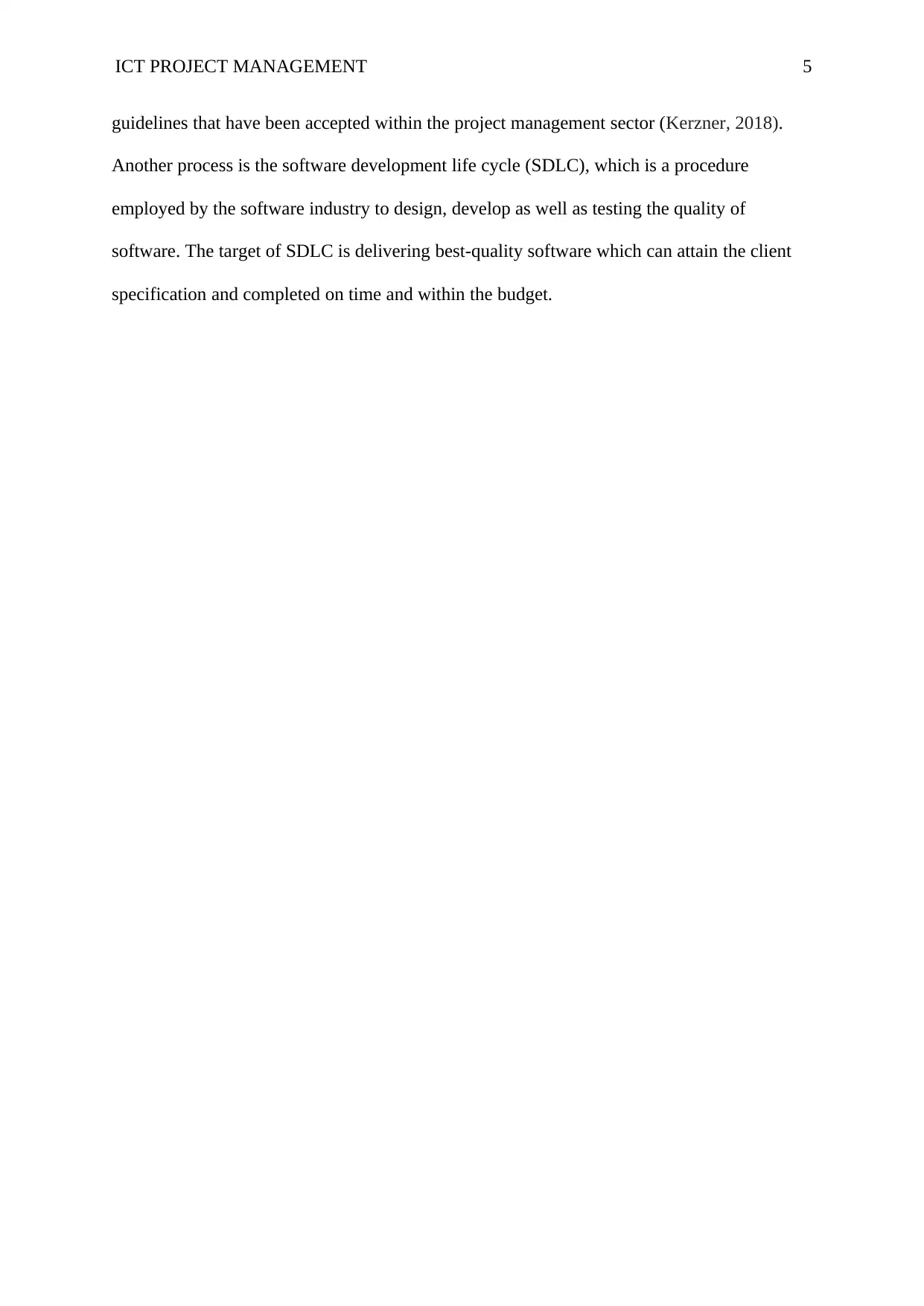
ICT PROJECT MANAGEMENT 5
guidelines that have been accepted within the project management sector (Kerzner, 2018).
Another process is the software development life cycle (SDLC), which is a procedure
employed by the software industry to design, develop as well as testing the quality of
software. The target of SDLC is delivering best-quality software which can attain the client
specification and completed on time and within the budget.
guidelines that have been accepted within the project management sector (Kerzner, 2018).
Another process is the software development life cycle (SDLC), which is a procedure
employed by the software industry to design, develop as well as testing the quality of
software. The target of SDLC is delivering best-quality software which can attain the client
specification and completed on time and within the budget.
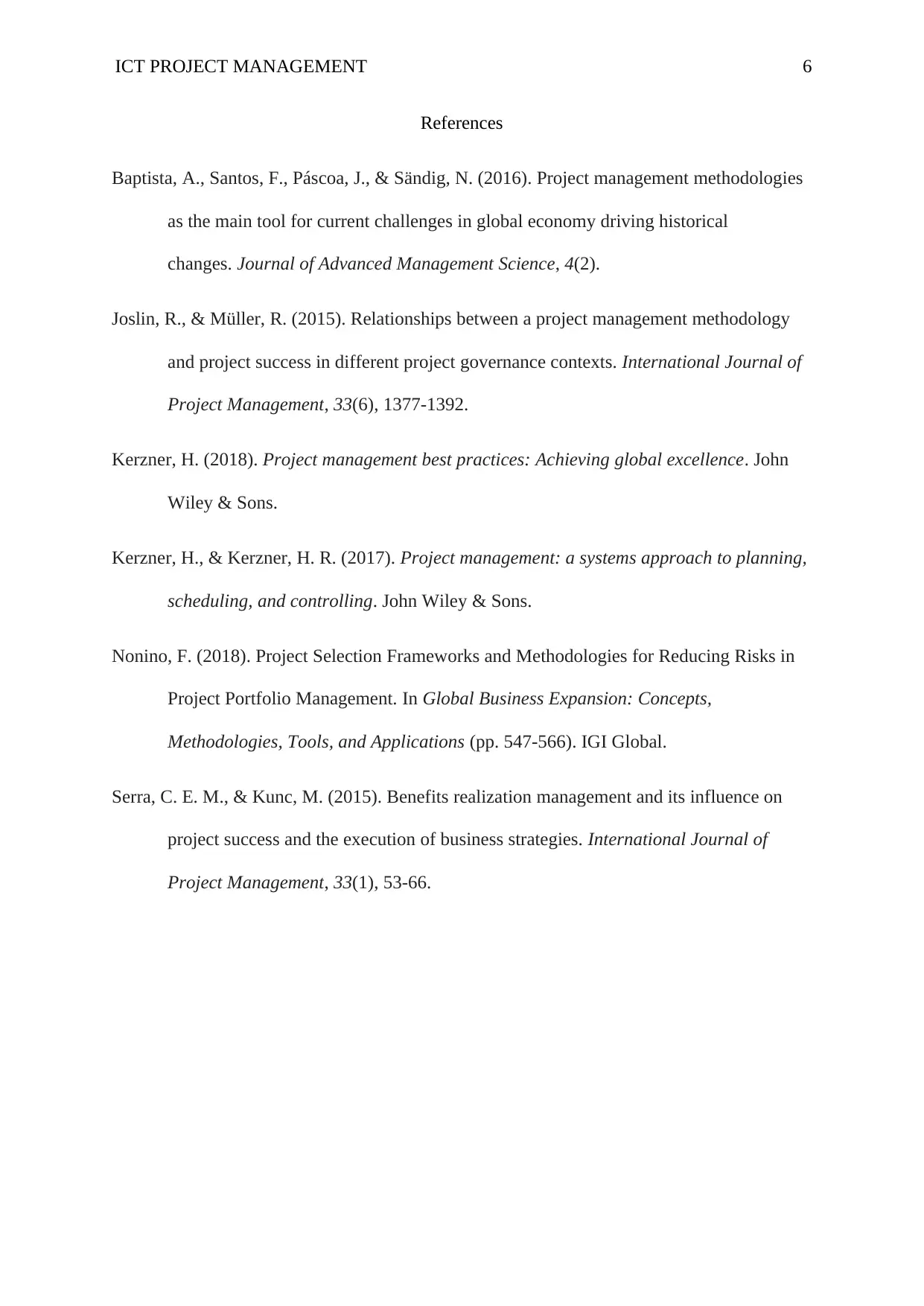
ICT PROJECT MANAGEMENT 6
References
Baptista, A., Santos, F., Páscoa, J., & Sändig, N. (2016). Project management methodologies
as the main tool for current challenges in global economy driving historical
changes. Journal of Advanced Management Science, 4(2).
Joslin, R., & Müller, R. (2015). Relationships between a project management methodology
and project success in different project governance contexts. International Journal of
Project Management, 33(6), 1377-1392.
Kerzner, H. (2018). Project management best practices: Achieving global excellence. John
Wiley & Sons.
Kerzner, H., & Kerzner, H. R. (2017). Project management: a systems approach to planning,
scheduling, and controlling. John Wiley & Sons.
Nonino, F. (2018). Project Selection Frameworks and Methodologies for Reducing Risks in
Project Portfolio Management. In Global Business Expansion: Concepts,
Methodologies, Tools, and Applications (pp. 547-566). IGI Global.
Serra, C. E. M., & Kunc, M. (2015). Benefits realization management and its influence on
project success and the execution of business strategies. International Journal of
Project Management, 33(1), 53-66.
References
Baptista, A., Santos, F., Páscoa, J., & Sändig, N. (2016). Project management methodologies
as the main tool for current challenges in global economy driving historical
changes. Journal of Advanced Management Science, 4(2).
Joslin, R., & Müller, R. (2015). Relationships between a project management methodology
and project success in different project governance contexts. International Journal of
Project Management, 33(6), 1377-1392.
Kerzner, H. (2018). Project management best practices: Achieving global excellence. John
Wiley & Sons.
Kerzner, H., & Kerzner, H. R. (2017). Project management: a systems approach to planning,
scheduling, and controlling. John Wiley & Sons.
Nonino, F. (2018). Project Selection Frameworks and Methodologies for Reducing Risks in
Project Portfolio Management. In Global Business Expansion: Concepts,
Methodologies, Tools, and Applications (pp. 547-566). IGI Global.
Serra, C. E. M., & Kunc, M. (2015). Benefits realization management and its influence on
project success and the execution of business strategies. International Journal of
Project Management, 33(1), 53-66.
⊘ This is a preview!⊘
Do you want full access?
Subscribe today to unlock all pages.

Trusted by 1+ million students worldwide

ICT PROJECT MANAGEMENT 7
Paraphrase This Document
Need a fresh take? Get an instant paraphrase of this document with our AI Paraphraser

ICT PROJECT MANAGEMENT 8
1 out of 8
Related Documents
Your All-in-One AI-Powered Toolkit for Academic Success.
+13062052269
info@desklib.com
Available 24*7 on WhatsApp / Email
![[object Object]](/_next/static/media/star-bottom.7253800d.svg)
Unlock your academic potential
Copyright © 2020–2025 A2Z Services. All Rights Reserved. Developed and managed by ZUCOL.



